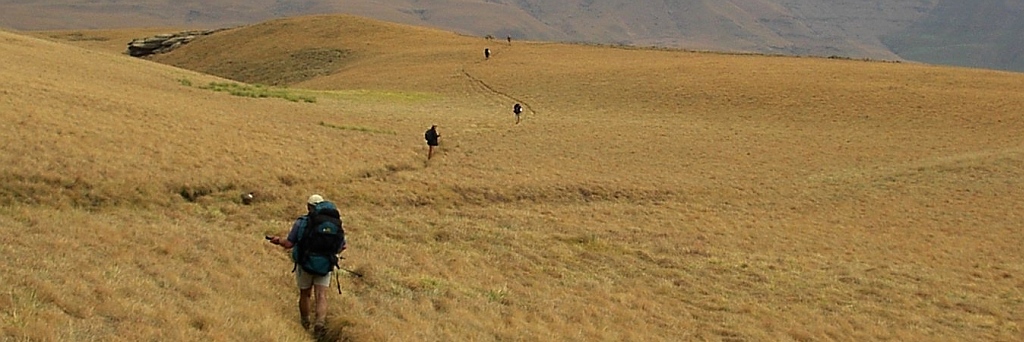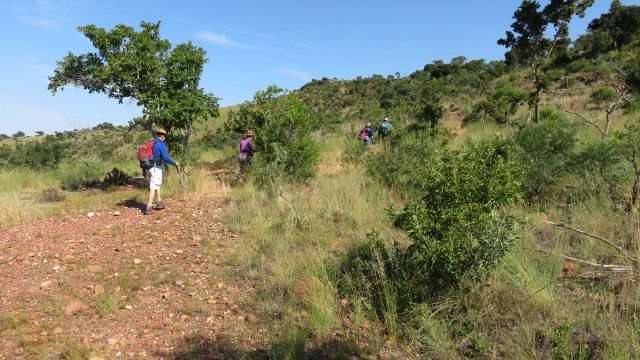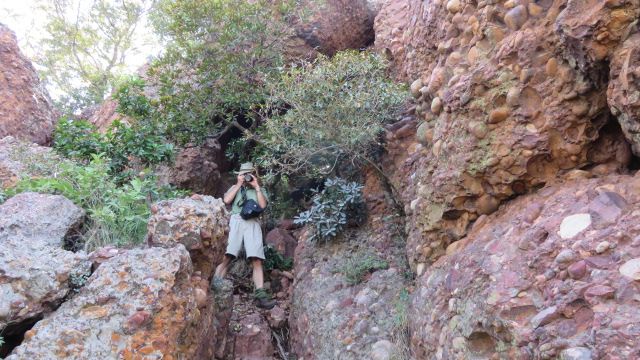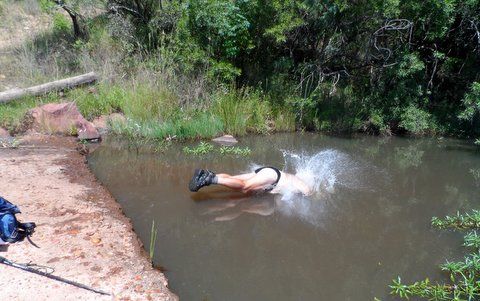

 Not to confuse this with the Wag n' Bietjie hike near Bothaville in the Free State. This one is just north-west of Warmbath. Fortunately Jenny was very quick with her summery of the hike, so I used it.
Not to confuse this with the Wag n' Bietjie hike near Bothaville in the Free State. This one is just north-west of Warmbath. Fortunately Jenny was very quick with her summery of the hike, so I used it.
It was nice not to have to drive too far, and we were all on-site way before dark.
Somehow we managed our food quite comfortably, notwithstanding the teeniest kitchen, which was interesting situated, in that the rather airy ablutions were between the kitchen and the scullery. Not everyone hiked, and some lazed in the camp. Our first day was hell hot, and the hike was terminated ½ way through and the rest of the day spent snoozing and chatting under the trees and dipping in the dam. Oscar was a feature on his electric tricycle; very fun! Followed by a jolly communal dinner.
 Second day's hiking was lovely. We finished the other half of the first day's hike, it seemed a bit cooler, very 'out of Africa' scenery with fields of pale waving grass, taller trees shading intermittent herds of zebra, gnus, bokkies and a number of giraffe.
Second day's hiking was lovely. We finished the other half of the first day's hike, it seemed a bit cooler, very 'out of Africa' scenery with fields of pale waving grass, taller trees shading intermittent herds of zebra, gnus, bokkies and a number of giraffe.  An unoccupied camp with radio blaring 'for the baboons' said the sign. Some swimming in pleasant streams to cool down, and not TOO much of the team talks and pointing in all directions. The most amazing thing was the STONES. The mountains there are one huge mass of conglomerate - smooth water-worn stones embedded in sandstone rock which are eroding out so the paths are just a treasure trove of lovely stones to be collected, it was a real 'knuckle on the ground' story for me! A pain to leave so many behind! I have pictures of the rocks but of course this morning my computer doesn't want to know about downloading, so will send later.
An unoccupied camp with radio blaring 'for the baboons' said the sign. Some swimming in pleasant streams to cool down, and not TOO much of the team talks and pointing in all directions. The most amazing thing was the STONES. The mountains there are one huge mass of conglomerate - smooth water-worn stones embedded in sandstone rock which are eroding out so the paths are just a treasure trove of lovely stones to be collected, it was a real 'knuckle on the ground' story for me! A pain to leave so many behind! I have pictures of the rocks but of course this morning my computer doesn't want to know about downloading, so will send later.
Yes, and the story of the conglomerate, why is it so wide spread? We know of this type of sedimentary rock, that is sandstone with smooth rocks in-bedded from many places in this area. If it was a river one would find it in a few places and not as a continuous strata for 100 or so kilometers around?
The explanation is in the book 'The Story of Earth & Life' by Terrence McCarthy and Bruce Rubidge, ISBN: 978 177007 148 3.
About 2700 million years ago the two semi continents Zimbabwe and Kaapvaal collided resulting in stress fractures leading to long valleys to be formed which got filled with water and sediments from the mountains. Best is read it in the book, I find it difficult to describe in words what I can hardly visualise.